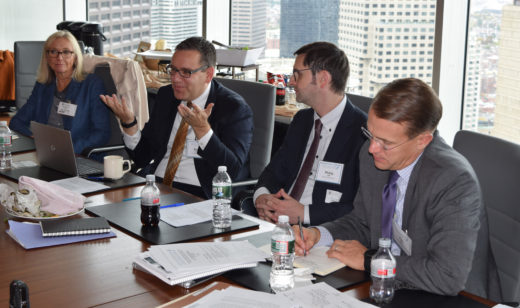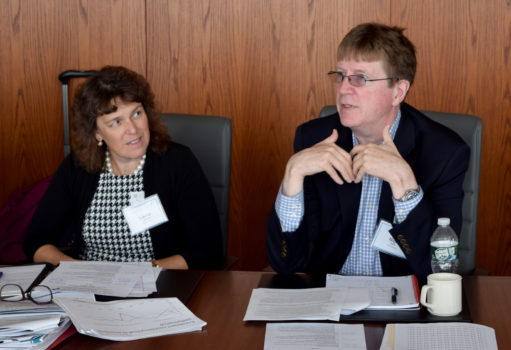NEBHE convenes leaders on the economy and the future of higher education …
Times are already complex for higher education. In Massachusetts, 18 higher education institutions (HEIs) have closed or merged in the past five years. In Vermont, College of St. Joseph, Green Mountain College and Southern Vermont College all held their final graduation ceremonies in the spring. What would happen if a recession were to add to this uncertainty?
With that question in mind, NEBHE in mid-October convened a small group* of economists and higher education leaders at the Federal Reserve Bank of Boston to talk about “The Future of Higher Education and the Economy: Lessons Learned from the Last Recession.”
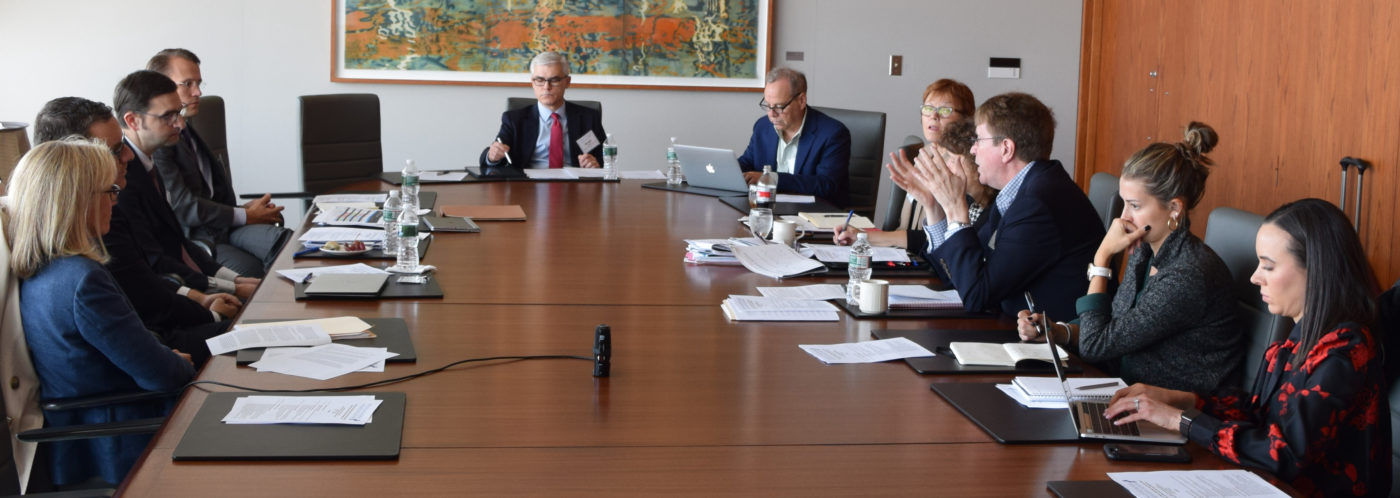
To be sure, some of the problems that have forced college closures are national, but New England (along with the rest of the Northeast and the Upper Midwest) faces specific challenges: most importantly, a daunting demography that spells trouble for college enrollments. By 2032, the number of new high school graduates in New England is projected to decline by 22,000 to a total 140,273, according to the Western Interstate Commission for Higher Education.
The NEBHE confab aimed to better understand the key challenges and consequences HEIs faced as a result of the so-called “Great Recession” and what can be learned from them. Among guiding questions:
- What is the likely course of the economy over the next 18 to 24 months?
- How prepared are institutions for the next recession?
- What lessons did higher education learn from the Great Recession?
- What conversations should HEIs—presidents, senior leaders, board leaders—be having now?
- How fragile are higher ed institutions in New England and beyond?
- What economic or other indicators should we be watching at this point in the economic cycle?
- What’s the impact of reduced or stagnant state and federal government support?
- How did the last recession impact families—and what does it mean for their ability to pay ever-increasing tuition and fees?
- When another recession hits, are there adequate social safety nets to cushion the blow?
- Which responses to changing demographics, customer preferences and new technology could help institutions avert closure … and even thrive?
The current state and future course of the economy
NEBHE President and CEO Michael K. Thomas opened the discussion asking for panelists’ perceptions of the state of the economy.
The U.S. has been enjoying the longest economic expansion in history. But looking worldwide, China’s economy is slowing, global manufacturing is suffering, and trading nations like Germany and Singapore are close to recession.
Nigel Gault, chief economist in the Boston office of EY-Parthenon, noted that the current expansion has been long (more than 10 years) but slow, not reaching 3% GDP growth in any year. Moreover, higher education enrollments have trended down while student loan debt has exploded. Tuition prices keep going up, raising increasing questions about whether the investment in higher education is worth it. And the demography will get even worse after 2025.
In addition, the international enrollment that kept some HEIs above water is under increased pressure. For international students, “it’s a combination of sensing they’re not wanted and facing more hurdles to get the necessary visa to come,” said Gault.
The overall result: fewer traditional-age college applicants.
“Back in the last expansion, enrollment was still growing 1 to 2%, which is not great, but this time, the expansion has been much slower overall, and enrollment growth is only half a percent to 1%,” said Thomas College President Laurie Lachance.
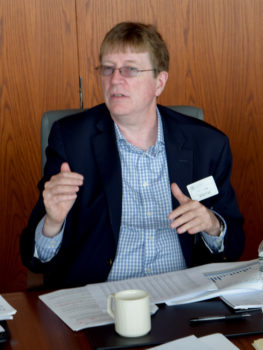
“Sentiment toward the value of a college degree has deteriorated because people see stories all the time about student debt … and they have heard of people going to certain for-profit schools and not coming out with any sort of qualification. When the labor market is so strong, they can get a decent, reasonably paying job without getting a college education. … We could see less responsiveness of the enrollment rate to a recession because of the damage that’s been done to the perception of value.”—Nigel Gault, chief economist in EY-Parthenon’s Boston office, on the value of college degrees.
In her previous roles as the Maine state economist and as corporate economist at Central Maine Power Company, Lachance heard from businesses that bad economic policy is better than frequently changing policy. She wondered if the current whiplash of national policies could tip us into recession.
Gault shared the thought: “Bad policy and volatile policy is a toxic combination. Often the best thing for the economy is policy paralysis because people know the rules are going to stay as they are now and they can plan on that basis.”
What kind of recession?
Recessions can result from global market downturns or be sparked by outside geopolitical events such as the Gulf War in the early 1990s or the subprime mortgage crisis that began in 2007 and led to the 2008 Great Recession.
None of the panelists thought a 2008-magnitude recession would come soon. But Gault suggested the No. 1 risk is the intensification of trade wars between the U.S. and China or the U.S. and Europe. Gault added that China can no longer play the role of savior of the global economy as it did after the Great Recession.
Participants agreed that different kinds of HEIs would be hurt differently by different kinds of recessions. Not only would a recession caused by global downturn be very different from one caused by local or even institution-specific financial factors. At the family level, a recession centered around the financial sector would directly hit a different group of New Englanders than one centered on manufacturing recession.
The panelists imagined multiple scenarios. Some elite HEIs with significant endowments will be hurt for a short time with a market downturn, but they’ll be OK. Some state universities will be too big to fail. Some independent HEI leaders wonder if state governments will consider consolidating low-performing public campuses? If some public HEIs adopt free tuition models, their programs will be hard to resist for students whose parents lose their jobs in a recession. But a downturn would slow public investment in such programs.
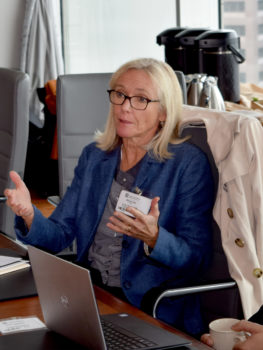
“Having a board of trustees that’s big enough that there’s a range of viewpoints is really helpful. There’s a healthy tension if one trustee says an institution has to have diversity of revenue streams through, for example, rentals of athletic facilities and graduate programs, but another one says, ‘Don’t go beyond your mission.’ In addition, as someone who has been a traditional academic, I’m not going to think of some opportunities people from other sectors might think of.” —University of Saint Joseph President Rhona Free on the makeup of boards of trustees.
If the past is a guide, any recession will bring some enrollment spurt, especially among older students because job options will be less plentiful, Gault observed. But unlike the tailwind during the Great Recession, the demographic headwind this time around, will probably result in a smaller enrollment spike. A modest recession that takes unemployment up to 6% could bring a less than 3% increase in annual enrollment, Gault said.
Even the recovery from the Great Recession varied by HEI based on the regions from which they drew students and whether their students were in programs that are cyclical or counter-cyclical, said University of Saint Joseph President Rhona Free. USJ’s latest focus has been nursing, teaching and social work, which were not especially hurt in 2008. The experience may have been different at liberal arts institutions that primarily offer disciplines, which in careerist times and places get reactions ranging from disparagement for having weak immediate career prospects to praise for being the key to critical thinking, noted Free, who was provost at Eastern Connecticut State University before joining USJ.
Endowment pressures
On average, 12% of operating budgets at HEIs are covered by endowments, though the figure at some wealthy institutions exceeds 50%, according to Timothy T. Yates, Jr., president and CEO of Commonfund Asset Management Company. He pointed out that most investment committees think of endowments by size, but the more important metric is how dependent institutions’ operating budgets are on endowment returns. He told of a private HEI where the share of operating budget covered by endowment went from 18% in 2008 to 15% in 2009. “That’s a huge hole in their operating budget and it took six years to recover.”
Moreover, most investment committees have not been happy with their recent return rates, Yates said. He explained that a market downturn on an endowment causes a drop in funding. HEIs generally draw about 5% from their endowments to support themselves. Yates said about 32% of HEIs have taken special-purpose appropriations from their endowments this year, up from 26% in 2017 and 18% in 2009. Some of these special appropriations have gone to marketing campaigns to drive enrollment; others have been aimed at addressing a deficit, Yates said.
“If people are drawing from their endowments with a one-time, one-year promise-we-won’t-do-it-again appropriation, I’m not sure that’s the way we should be operating. It’s potentially a Hail Mary activity.” said Susan Whealler Johnston, president and CEO of the National Association of College and University Business Officers (NACUBO).
Lachance saw all the high-finance handwringing as “first-world” problems. Her Thomas College, with just 800 undergraduates and a $13 million endowment, was on the brink of bankruptcy three decades ago. Now, the college, located in the same Maine town as the richer Colby College (which has 2,000 undergraduates and an endowment of more than $800 million), makes tough business decisions to invest in only things that could lead to higher enrollment. Thomas draws just a few percentage points of its endowment annually for its operating budget.
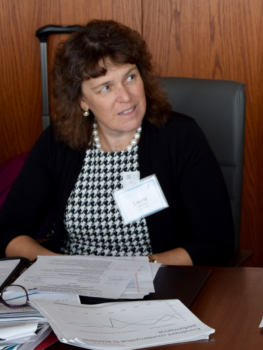
“We now have three-year undergraduate degrees in every major. That’s a game-changer. Colleges can’t cut their way to sustainability. They’d have to fire all the faculty, which doesn’t work. So we now offer high-performing students a three-year degree and they can stay and get their master’s in a fourth year.”—Laurie Lachance, president of Thomas College, on shortened time to degree.
Among new business models, Thomas College has added three-year degrees for high-performing high school students, and key employability programs such as a “golf guarantee” to make sure students, many the first in their families to attend college, graduate networking-ready and more familiar with practical realities of business leadership.
The demographic factor
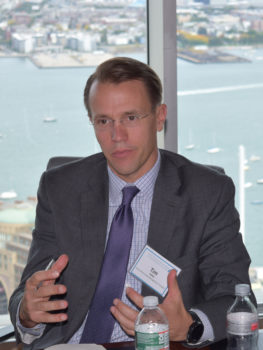
“Some colleges figure out which admits have a better probability of staying and are offering those students the very scarce student aid funds.” —Timothy T. Yates, Jr., president and CEO of Commonfund Asset Management, on allocating resources to students.
In the 1970s and early ‘80s, when endowment values dropped sharply, high inflation exacerbated the problem, Yates said. But what higher ed had at that time was a big demographic tailwind with baby boomers starting to come into colleges. Baby boomers now represent about 25% of the population but nearly half of charitable giving.
Also in the ‘70s, higher ed saw the front end of more structured fundraising and the consolidation benefits of single-sex institutions merging. Plus, since there hadn’t yet been large tuition increases, there was room to fill classes with students who were willing to pay more. “In higher education, history has been kind to the continuation of bad business practices, for example, thinking you could just go on and on raising tuition,” Lachance said. But our expert panelists agreed that such slack was no longer in the system.
All in all, a lot of New England higher education’s fortunes can be tied to an aging population. Too few babies are being born to sustain our overbuilt higher education infrastructure. Adults, though underserved, are seen as possible saviors. Professors are aging too, and the older ones are less likely to buy into cost-saving technology and open-education resources that some HEIs such as Thomas College consider a key to success. College presidents, whose average tenure is less than seven years, and chief business officers are also heading toward a retirement cliff.
Johnston reflected on the challenges of HEI governance and added that a lot of board members are in their seventies and will be retiring soon. “Are they the big givers that institutions want to hold onto, or do we need new bring in younger, different thinkers?” Or is the best approach to encourage both, since senior trustees can help newer board members with the institutional context for board decision-making?
Young blood with a new perspective may also bring more honesty to boards. Roger Goodman of the Yuba Group and previously Moody’s (where he wrote for NEJHE during the last recession) was surprised when a poll at a recent conference for higher education trustees showed nearly 65% believed their HEIs were on a solid financial footing. Such findings suggest a certain level of naivete or denial about the realities facing HEIs.
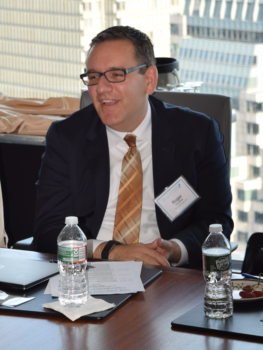
“As labor markets get tight, students and families might question the value of getting degrees but also companies may think, ‘Can we offer our own credentialing and training in a more focused way than a four-year degree and attract employees sooner and with more tailored skills?’ Even once the labor market loosens up, the shift away from degrees may stick.” —Roger Goodman, a partner in the Boston office of The Yuba Group LLC, on the future of degrees.
Then, there are questions about the whole higher education governance model. Board members’ connections to the world outside higher ed surely bring value. But does someone who’s made millions in private equity know the complexities of dealing with a shared governance model and the challenges of higher ed finances? And what about those trustees of public HEIs, some named to boards partly based on connections to governors and other appointing authorities?
Student loans and defaults
One of higher education’s biggest challenges is captured by a staggering number: $1.6 trillion. That’s the current total amount of student loan debt. And unlike other forms of consumer credit, student loan debt is only rising.
Phil Oliff noted that a fifth of federal loan borrowers are in default. There has been much discussion about how student loan debt itself may delay markers of adulthood such as buying a car or home, starting a family or starting a business. Default is an even bigger deal. Wages can be garnished. In some places, professional certifications can be stripped. And credit scores can be hit.
Notably and counterintuitively, the higher defaults are among students with low balances, often because they left college without completing a degree that would provide the earnings to repay their loans.
In Maine, not just community colleges but also lower-tiered university campuses, have higher default rates. Higher default rates seem to be more highly correlated with low graduation rates than they are with larger loan balances. For example, Maine Maritime graduates incur high debt levels but very low default rates, said Lachance.
Much was made of defaults among students at for-profit colleges. But enrollment at for-profits has plummeted since spiking around the time of the last recession.
Public investment in higher education
State funding of higher education has come back somewhat and state fiscal reserves have been built up since the Great Recession, said Oliff. But public higher ed gets disproportionately hit in recessions—as it is seen as a “balance wheel” for legislators struggling to write budgets during downturns.
In the last recession, Oliff added, the federal government created a specific pot of money for states to prop up
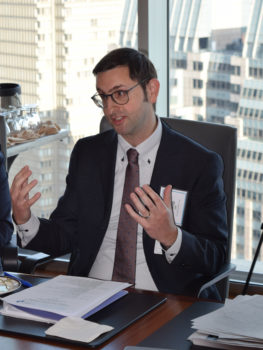
“It tends to be people with the lowest balances who default on their loans often because they drop out of school … Your probability of default is inversely proportional to your debt level.” —Phillip Oliff, senior manager at The Pew Charitable Trusts, on debt and completion.
budgets, plus policy decisions to increase the maximum Pell Grant award, veterans benefits and tax expenditures, such as credits for tuition and college savings incentives. The impact of the last recession, albeit significant, was softened by federal policy interventions. But there’s no guarantee that D.C. will act in the same way in the next recession.
The student debt issue also feeds into and grows out of the changing perceptions of the value of higher education. Increasing critiques of higher ed could affect the cyclical dynamic that has sent more students back to college during recessions. When a recession occurs, will some people question if investing in some or more higher education is a good strategy? Further, shorter-term credentials, rather than degrees, may be key in a changing economy, Gault said. Indeed, NEBHE and others increasingly focus on how “high-value” credentials can more efficiently prepare students for in-demand jobs than can full degree programs.
As an immigrant, USJ’s Rhona Free said she always saw “part of the American Dream is that your 18-year-old goes off to live on a campus and grows in many ways for four years, but the reality is that is largely a middle-class, upper-income, white American Dream. We have to innovate in getting all families to believe that this is achievable for their children and there’s a good return on investment. It will be less debt than if they bought a new car.”
Mergers and alliances
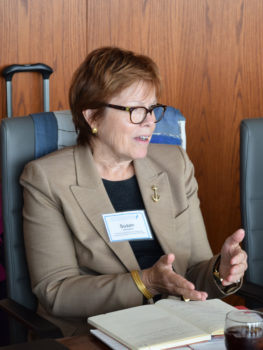
“Mergers are a logical thing to talk about and more in the air these days … But people are very squeamish about it and only come to it when they’re hard-pressed, which is too late.”—Susan Whealler Johnston, president and CEO of the National Association of College and University Business Officers (NACUBO), on mergers.
Johnston warned that presidents and boards should be talking about what alliances and mergers might mean to their institutions. But many do not want to talk about it, until they’re hard-pressed. Some of that is reflected in the sentiment noted by Goodman in which two-thirds of board members saw their HEIs as being on solid ground.
In addition, the process of mergers can put a lot of pressure on surviving HEIs. An institution facing the threat of closure might decide to get by for another year with an unsustainable discount, say 75%, to get the incremental student it wants. That can put a lot of pressure on other HEIs that are competing in the market. Johnston pointed out that one HEI in Virginia, determined to grow its enrollment, decided to go deeper into its waiting lists, which affected enrollments at competitors across the state, many of whom did not meet their revenue goals as a result.
“The business model isn’t working for us, and that requires innovation,” said Johnston. And it is explained poorly to the public and students with confounding concepts such as “tuition discounts” and “net prices vs. sticker prices.”
Students and families
When the discussion turned to the condition of social safety nets, Lachance lamented: “The rich are getting richer, the poor are getting poorer. When I was growing up, there were so many mills around us where a high school grad could do just fine. They’d get on a union wage scale and they had a great standard of living to send their own kids to college. Now it seems like the difference is based on your educational attainment. And if you don’t attend college and you don’t persist and graduate, you’ll never earn the return on that investment and you’ll be in debt.”
A recession will surely exacerbate the difference between those who have and those who have not, concluded Johnston. The question is not just which institutions will be most affected, but which students, for example, those with food insecurity. As President Free noted, HEIs’ food pantries and in-demand mental health services are now key social safety nets upon which many students already depend.
Moreover, “Kids who were watching their families go through the last recession may bring a separate set of anxieties with them if there’s another recession,” said Johnston. “They may dial back what they think they can do even if the circumstances don’t require it.”
John O. Harney is executive editor of The New England Journal of Higher Education.
Some additional insights from our expert panelists …
“In Connecticut, half of community college students who start full-time over age 25 don’t persist anywhere. Retention and persistence is critical for students and their institutions. Students who start full-time and don’t persist incur a lot of opportunity costs and the resources used for them were underutilized.”—Free
On revenue growth.
“What does revenue growth look like? Is there access to the financial information on a program or degree basis? It is not necessarily that everything has to make a profit, but institutions should have the information to make rational decisions. Two-thirds of institutions that Moody’s rates haven’t had revenue growth above 1 or 2% in recent years.”—Goodman
“There’s value in benchmarking too, knowing what your institutions trends in enrollment look like compared with peer competitive institutions.”—Goodman
On specific disciplines.
“Are the programs we’re offering the type that come into demand in recession? Or are we over-indexed in those programs that won’t be in demand? The trick is in the detail of where any individual institution fits in this big picture. And that’s just enrollment, not endowments.”—Gault
On longer-term views.
“We should make sure board members are looking a number of years down the road. … There’s a loss of forward momentum when you have turnover in leadership that’s hard to overcome … So you have stasis and ideas that don’t have enough time to get buy in. It’s quite concerning for higher ed.”— Johnston
On endowments.
“If the [stock] market goes bust … of course, it’s going to pinch. But we’ve cut far more than that from our budget because of demographics.”—Lachance
On debt and ROI.
“We have all this focus on student debt, when we should be looking at the risk of students not earning a return on their investment. … We want students to complete their college wherever they go.”—Lachance
On retention.
“Paying attention to retention is a good business decision … It’s easier to keep a customer you have than to have to generate new customers.”—Lachance
“In recent years, student loans have consistently had higher shares of balances in serious delinquency than other forms of consumer credit like mortgages or credit cards. There is still a lot we don’t know about why so many people continue to struggle.”—Oliff
On baby boomers and wealth transfer.
“While we have a demographic headwind with respect to students, baby boomers are retiring and there will be a transfer of wealth. Investing in development and fundraising is critical in the long term, Baby boomers are 25% of the population and they represent almost half of charitable giving.”—Yates
On international declines.
“At some colleges, the budget is made or broken by 20 or 30 international students, all of whom are full pay. Some were very aggressive going to China and the Middle East to attract students. But in the current political environment, that trend is reversing.”—Yates
* About the panelists …
Rhona C. Free became the ninth president of the West Hartford, Conn.-based University of Saint Joseph in July 2015. During her time at USJ, she has championed the creation of the Women’s Leadership Center and guided the deliberations that led to the university’s decision to become fully coeducational in fall 2018. She joined USJ from Eastern Connecticut State University, where she served as vice president for academic affairs from 2007 to 2013 and provost from 2013 to 2015. She taught Economics at Eastern for 25 years before becoming an administrator.
Roger Goodman is a partner in the Boston office of The Yuba Group LLC, which provides independent financial advice and consulting to higher education institutions on debt and credit-related matters. Prior to joining the Yuba Group, he served as the team leader for the Higher Education and Not-for-Profit Team at Moody’s Investors Service, leading a team of 11 analysts responsible for credit analysis and credit ratings.
Nigel Gault is EY-Parthenon’s chief economist based in the Boston office. He was with Parthenon for a year before its combination with EY in August 2014. He advises clients on issues relating to their strategies, market growth and pricing. Gault was most recently chief U.S. economist at IHS Global Insight, where he was a seven-time winner of the Marketwatch Forecaster of the Month accolade for key economic indicators. He has also served as chief European economist in London for Standard & Poor’s/Data Resources and for Decision Economics.
Susan Whealler Johnston is president and CEO of the National Association of College and University Business Officers (NACUBO), a position she has held since Aug. 1, 2018. Prior to joining NACUBO, she was at the Association of Governing Boards of Universities and Colleges (AGB), where she served as executive vice president and chief operating officer, responsible for the day-to-day operations of the organization as well as strategic planning. Prior to joining AGB, she was professor of English and dean of academic development at Rockford University.
Laurie Lachance is Thomas College’s fifth president and the first female and alumna to lead the college in its 125-year history. From 2004 to 2012, she served as president and CEO of the Maine Development Foundation. Prior to MDF, she served three governors as the Maine state economist. Before joining state government, she served as the corporate economist at Central Maine Power Company.
Phillip Oliff is senior manager at The Pew Charitable Trusts in Washington, D.C., where he leads Pew’s work exploring the fiscal and policy relationships between the federal and state governments on a variety of topics, including how federal budget and tax changes could affect states, the role that federal and state finances play in higher education and surface transportation. He previously was a policy analyst at the Center on Budget and Policy Priorities, where he wrote reports on topics including education finance, state tax policy, states’ post-recession fiscal conditions and the impact of emergency federal aid on state budgets.
Timothy T. Yates, Jr. is president and CEO of Commonfund Asset Management and responsible for managing all aspects of Commonfund’s Outsourced Chief Investment Office (OCIO) business, which focuses exclusively on nonprofit institutions. Before joining Commonfund, he was an instructor of Spanish and Italian at Fordham Preparatory School in the Bronx, N.Y.
[ssba]

